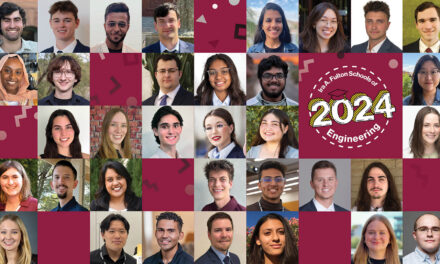
Reimagined hospital bed minimizes risk of pressure ulcers
Online team’s invention wins the Palais Senior Design Prize

Above: Hadassah Fromowitz, a senior in the electrical engineering program in Arizona State University's Ira A. Fulton Schools of Engineering, operates the mobile interface of the Personal Care E-ssistant, a reimagined hospital bed designed to minimize the risk of pressure ulcers. Photo courtesy of Hadassah Fromowitz
Electrical engineering students in Arizona State University’s Ira A. Fulton Schools of Engineering completed their final capstone course with a bang. For one team, it ended with an award and the reward of carrying out a project that makes a difference for patients staying in hospitals.
Seniors worked on a two-semester design project to fulfill all of the academic requirements for a bachelor’s degree in electrical engineering while gaining experience to prepare for the workplace. The course culminated at Demo Day with students presenting projects to the public in trade-show fashion.
“This is very much ‘finishing school’ for electrical engineers,” says Michael Kozicki, the senior design program coordinator and a professor of electrical engineering in the School of Electrical, Computer and Energy Engineering, one of the six Fulton Schools.
“The goal is to make our students extremely valuable in the job market. Yes, we produce highly technical individuals — four years of a rigorous curriculum will do this — but our differentiator is the soft skills we instill through the capstone.”
Fifty-six senior design teams competed in the spring semester electrical engineering Demo Day. The projects ran the gamut from solar-powered battery chargers and smart photovoltaics converters to an automated pool chemical system and an evacuation indicator system. Each project integrated multiple facets of electrical engineering and other disciplines to solve a societal challenge.
For the first time in Demo Day history, a team of online students claimed the Palais Senior Design Prize with a design for a reimagined hospital bed.
The Palais Senior Design Prize was established in 1998 to recognize the best senior design project in electrical engineering. The award is presented each semester to a student team whose capstone design project demonstrates technical prowess and clear value for society. Students also must communicate their research, design efforts and outcomes in ways that can be understood by people other than scientists and engineers.
Winners of the competition receive a small cash prize funded by Professor Emeritus Joseph Palais.
“The majority of our online teams are superbly well organized. The online students know how to plan and execute,” says Kozicki. “However, performing a team project, and particularly a hardware project when the team members are spread around the planet, is a huge challenge that involves an extra level of determination and an additional modicum of ingenuity.”

An overview of the subsystems and features of the Personal Care E-ssistant, an updated design of a hospital bed to relieve and prevent pressure ulcers. The bed was created by a team of electrical engineering students as part of their capstone senior design project. Photo courtesy of Hadassah Fromowitz
Personal Care E-ssistant, a project worthy of the Palais Prize
Under the mentorship of Associate Professor Pavan Turaga, electrical engineering seniors Makayla Donaldson, Hadassah Fromowitz, Robert Graves, Olivia Ruthven and Timothy Sparks designed and built a hospital bed called the Personal Care E-ssistant that minimizes the risk of pressure ulcers.
According to the Agency for Healthcare Research and Quality and a recent study, more than 2.5 million individuals in the U.S. develop pressure ulcers annually and an estimated 60,000 Americans die each year as a direct result of pressure ulcers. The team worked together on a solution to address this large-scale issue.
The inspiration for the project came from one of Fromowitz’s relatives whose spouse was bedridden due to medical complications. Distraught about the damage to his skin, infections and wounds that required multiple dressing changes, she asked if Fromowitz could do something to prevent the bed sores.
Other team members had similar memories of relatives in hospital settings. They jumped at the chance to help create a solution that would not only improve the standard of care and quality of life for bedridden patients but also reduce the risk of caregiver injury.
“There are many factors that contribute to the formation of pressure ulcers,” says Fromowitz. “Our bed works by targeting three of the main concerns: prolonged pressure, poor blood circulation and shear and friction.”
Prolonged pressure occurs when a patient lays in the same position for an extended period of time. Caregivers can alleviate pressure by rotating the patient 30 degrees to their side periodically. However, it’s not always easy for caregivers to rotate patients on a consistent schedule.
The Personal Care E-ssistant makes rotating the patient easy. The caregiver simply presses a button on a remote control or a wireless interface, and the patient is tilted 30 degrees. Caregivers can also set a timer to have the E-ssistant automatically rotate a patient at scheduled intervals.
Graves designed the bed rotation subsystem with two linear actuators (a component of a machine that provides controlled movements) programmed to raise and lower the left and right sides of the bed. The bed can be adjusted from a handheld remote, mobile device or computer terminal.
Poor blood circulation is a result of patient immobility, which leads to cell death and eventually skin and muscle breakdown. Caregivers can move the patient’s extremities to increase blood flow and lessen the likelihood of skin breakdown.
Ruthven designed, coded and built the bed’s passive motion that allows caretakers to increase patients’ blood circulation without manually moving them. Caregivers can set up an automated cycle whereby the patient’s upper body and legs are slowly raised and lowered according to a schedule.
“This feature decreases the risks of caretakers hurting themselves during the process of moving the patient and the patient hurting themselves during the process of being moved,” says Ruthven. “If any problem occurs during the passive movement, the stop button can be used to cease all movement.”
Shear ensues when a patient slips down in bed and gravity pushes downward on the patient’s body. Friction is the force created by the patient’s body rubbing against the bed sheets. A combination of both can result in pressure ulcers.
Donaldson worked on a safety sensor subsystem to detect when patients are positioned too high or too low in bed and notify a caregiver. If patients need to be lifted, the conveyor belt feature in the mattress can be activated to reposition patients without further damaging their skin.
“The conveyor belt rolls in the direction specified so the patient is moved back into place without being dragged across the sheet,” says Fromowitz, who developed the plans for the conveyor belt and wrote the code to run this subsystem. “This also helps keep caregivers from injuring themselves while pulling heavy patients into place.”
Fromowitz also designed and built the bed frame in collaboration with a carpenter to ensure all features could work in unison. She then integrated all the subsystems into a final prototype with the help of the original subsystem designer.
Sparks confirmed each of the subsystems worked with Wi-Fi and the bed’s control interface system. He also integrated a number of different microcontrollers so they could be controlled remotely.
“The team was extremely organized and had superlative project management skills,” says faculty mentor Turaga. “Everyone was motivated and eager to contribute.”
Completing the project completely online
The winning senior design team had members in California, New York, Ohio and Tennessee. As students in the Fulton Schools’ online electrical engineering program, they understood the challenges of working remotely, so they honed the communication and planning skills necessary to make the project successful.
“Working online means there has to be a serious effort in communicating specs and details very clearly so everything can come together and fit in the end,” says Fromowitz. “It also required splitting up the work and then setting clear goals and deadlines so everyone’s schedule could be accommodated and still get our project done and our work submitted on time.”
Team members communicated via Slack for daily conversations, Google Hangouts for group conference calls and Google Team Drive for document sharing. Their tasks were tracked in an online project management tool called Asana.
“In most traditional capstone projects, the defining experience is one of teamwork and collaboration intended to prepare students to enter the workforce with sufficient soft skills in addition to discipline-specific skills,” says Turaga. “The notion that such skills can be developed online has been met with skepticism. That’s why I feel this online team’s output is so impressive, and the fact that they won the Palais Prize is even more remarkable.”
Team members were stunned when they found out they had won the Palais Prize, especially because of the range of innovative senior projects presented at Demo Day.
“Our team is very happily surprised we were the first online team to win this honored prize,” says Fromowitz.
“Working remotely, sometimes it’s hard to tell if our work is being given the same attention as the work of those students on campus. We miss out on the nod or smile from the instructor that shows us we’re doing OK,” she says. “Winning this prize was an affirmation that online students are being equally considered and was a very satisfying ‘nod and smile’ from the team of judges.”



































